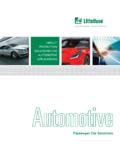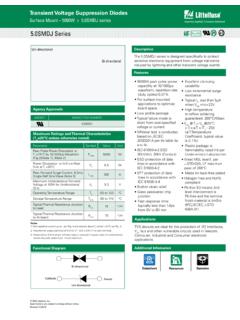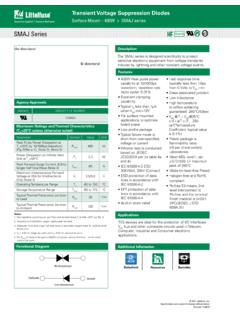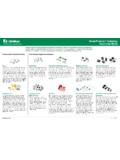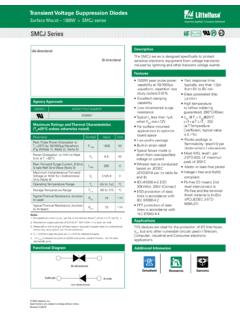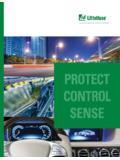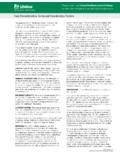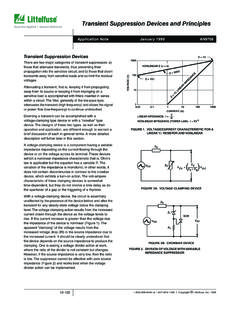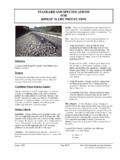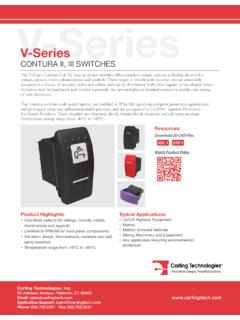Transcription of Selection Guide Fuse Characteristics, Terms and ...
1 Selection Guide fuse characteristics , Terms and Consideration factors FUSEOLOGY. Selection Guide fuse characteristics , Terms and Consideration factors About this Guide Fuses are current-sensitive devices that provide reliable protection for discrete components or circuits by melting under current overload conditions. Choosing the right fuse for your application can be an overwhelming, time-consuming process, even for a seasoned electronics design engineer. This user-friendly Fuseology Selection Guide makes the fuse Selection process quick and easy-helping you optimize the reliability and performance of the application.
2 Table of Contents Page fuse characteristics , Terms and Consideration factors 2 4. fuse Selection Checklist 5 7. PTC characteristics and Terms 8 9. PTC Product Applications 10. Typical PTC Circuit Protection Designs 11. Standards 12 14. PTC Selection Worksheet 15. fuse and PTC Products Selection Guide 16 18. Packaging and Part Numbering 19. Legal Disclaimers 20. 2014 Littelfuse, Inc. Specifications descriptions and illustrative material in this literature are as accurate as known at the time of publication, but are subject to changes without notice. Visit for more information. Fuseology Selection Guide fuse characteristics , Terms and Consideration factors The purpose of this introductory section is to promote these standards include: fully enclosed fuseholders, high a better understanding of both fuses and common contact resistances, air movement, transient spikes, and application details within circuit design.
3 Changes in connecting cablesize (diameter and length). Fuses are essentially temperature-sensitive devices. Even The fuses to be considered are current sensitive devices small variations from the controlled test conditions can designed to serve as the intentional weak link in the greatly affect the predicted life of a fuse when it is loaded electrical circuit. Their function is to provide protection of to its nominal value, usually expressed as 100% of rating. discrete components, or of complete circuits, by reliably melting under current overload conditions. This section The circuit design engineer should clearly understand will cover some important facts about fuses, Selection that the purpose of these controlled test conditions is to considerations and standards.
4 Enable fuse manufacturers to maintain unified performance standards for their products, and he must account for The application guidelines and product data in this Guide the variable conditions of his application. To compensate are intended to provide technical information that will for these variables, the circuit design engineer who is help with application design. The fuse parameters and designing for trouble-free, long-life fuse protection in his application concepts presented should be well understood equipment generally loads his fuse not more than 75%. in order to properly select a fuse for a given application.
5 Of the nominal rating listed by the manufacturer,keeping in mind that overload and short circuit protection must be Since these are only a few of the contributing parameters, adequately provided for. application testing is strongly recommended and should be used to verify performance in the circuit / application. The fuses under discussion are temperature-sensitive devices whose ratings have been established in a 25 C. Littelfuse reserves the right to make changes in product ambient. The fuse temperature generated by the current design, processes, manufacturing location and information passing through the fuse increases or decreases with without notice.
6 For current Littelfuse product infomation, ambient temperature change. please visit our web site at The ambient temperature chart in the fuse Selection . AMBIENT TEMPERATURE: Refers to the temperature CHECKLIST section illustrates the effect that ambient of the air immediately surrounding the fuse and is not to temperature has on the nominal current rating of a fuse . be confused with room temperature. The fuse ambient Most traditional Slo-Blo fuse designs use lower melting temperature is appreciably higher in many cases, because temperature materials and are, therefore, more sensitive to it is enclosed (as in a panel mount fuseholder) or mounted ambient temperature changes.
7 Near other heat producing components, such as resistors, transformers, etc. DIMENSIONS: Unless otherwise specified, dimensions are in inches. BREAKING CAPACITY: Also known as interrupting rating or short circuit rating, this is the maximum approved The fuses in this catalog range in size from the approx. current which the fuse can safely break at rated voltage. 0402 chip size (.041 L .020 W .012 H) up to the 5. Please refer to the INTERRUPTING RATING definition of AG, also commonly known as a MIDGET fuse (13/32 . this section for additional information. Dia. 11/2 Length). As new products were developed throughout the years, fuse sizes evolved to fill the various CURRENT RATING: The nominal amperage value of the electrical circuit protection needs.
8 fuse . It is established by the manufacturer as a value of current which the fuse can carry, based on a controlled set The first fuses were simple, open-wire devices, followed of test conditions (See RERATING section). in the 1890's by Edison's enclosure of thin wire in a lamp base to make the first plug fuse . By 1904, Underwriters Catalog fuse part numbers include series identification Laboratories had established size and rating specifications and amperage ratings. Refer to the fuse Selection to meet safety standards. The renewable type fuses and CHECKLIST section for guidance on making the proper automotive fuses appeared in 1914, and in 1927 Littelfuse choice.
9 Started making very low amperage fuses for the budding RERATING: For 25 C ambient temperatures, it is electronics industry. recommended that fuses be operated at no more than The fuse sizes in following chart began with the early 75% of the nominal current rating established using the Automobile Glass fuses, thus the term AG . The controlled test conditions. These test conditions are part of numbers were applied chronologically as different UL/CSA/ANCE (Mexico) 248-14 Fuses for Supplementary manufacturers started making a new size: 3AG, for Overcurrent Protection, whose primary objective is example, was the third size placed on the market.
10 Other to specify common test standards necessary for the non-glass fuse sizes and constructions were determined by continued control of manufactured items intended for functional requirements, but they still retained the length protection against fire, etc. Some common variations of or diameter dimensions of the glass fuses. Their 2014 Littelfuse Fuseology Selection Guide 2 Fuseology Selection Guide fuse characteristics , Terms and Consideration factors (continued). designation was modified to AB in place of AG, indicating fuses up to 200,000 amperes for the 600 VAC KLK series. that the outer tube was constructed from Bakelite, fibre, Information on other fuse series can be obtained from the ceramic, or a similar material other than glass.
